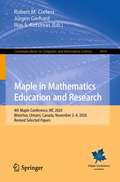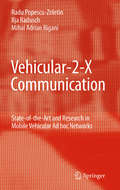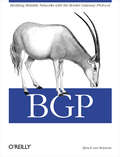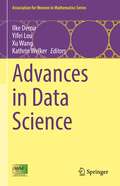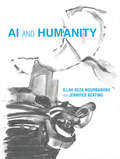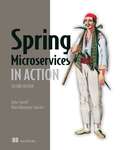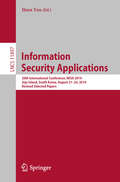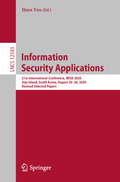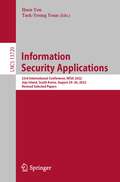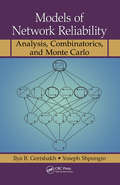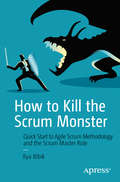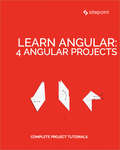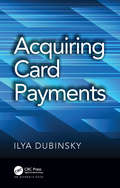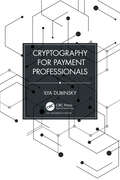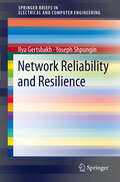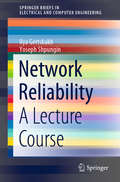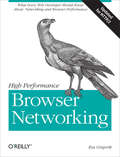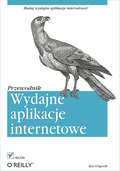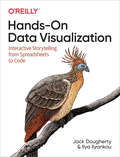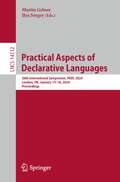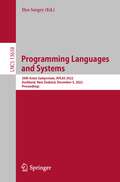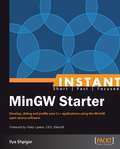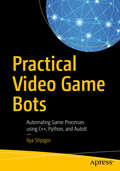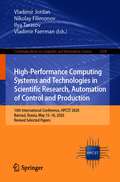- Table View
- List View
Maple in Mathematics Education and Research: 4th Maple Conference, MC 2020, Waterloo, Ontario, Canada, November 2–6, 2020, Revised Selected Papers (Communications in Computer and Information Science #1414)
by Ilias S. Kotsireas Jürgen Gerhard Robert M. CorlessThis book constitutes refereed proceedings of the 4th Maple Conference, MC 2020, held in Waterloo, Ontario, Canada, in November 2020. The 25 revised full papers and 3 short papers were carefully reviewed and selected out of 75 submissions, one invited paper is also presented in the volume. The papers included in this book cover topics in education, algorithms, and applciations of the mathematical software Maple.
Vehicular-2-X Communication
by Radu Popescu-Zeletin Ilja Radusch Mihai Adrian RiganiThe European Car-to-Car Communication Consortium in relation with the American Vehicle Safety Communication project has been playing a key role in the development of the concepts and technologies which are now at the origin of the standardization activities and research projects (PREVENT, SAFESPOT, CVIS) being introduced. Many safety applications (some of them being summarized here) will use this standard infrastructure for contributing to a safer road environment. Along the ISO OSI reference model the authors describe medium access control, routing in WAVE/DSRC (Dedicated Short Range Communications), 802.11p, and accompanying standards based on the communication architecture defined by the Car-to-Car Communication Consortium and the National Vehicle Infrastructure Integration Consortium (VIIC), as within the Federal ITS Program (RITA). Furthermore, this book introduces and describes future automotive applications such as cooperative driving utilizing such car-2-X (or vehicle-2-x) communication between vehicles and road infrastructure. Validation of these novel applications is a must before market introduction. Therefore this book introduces comprehensive simulation environment combining existing approaches for application, traffic and network simulation.
BGP: Building Reliable Networks with the Border Gateway Protocol
by Iljitsch Van BeijnumBorder Gateway Protocol (BGP) is the routing protocol used to exchange routing information across the Internet. It makes it possible for ISPs to connect to each other and for end-users to connect to more than one ISP. BGP is the only protocol that is designed to deal with a network of the Internet's size, and the only protocol that can deal well with having multiple connections to unrelated routing domains.This book is a guide to all aspects of BGP: the protocol, its configuration and operation in an Internet environment, and how to troubleshooting it. The book also describes how to secure BGP, and how BGP can be used as a tool in combating Distributed Denial of Service (DDoS) attacks. Although the examples throughout this book are for Cisco routers, the techniques discussed can be applied to any BGP-capable router.The topics include:Requesting an AS number and IP addressesRoute filtering by remote ISPs and how to avoid thisConfiguring the initial BGP setupBalancing the available incoming or outgoing traffic over the available connectionsSecuring and troubleshooting BGPBGP in larger networks: interaction with internal routing protocols, scalability issuesBGP in Internet Service Provider networksThe book is filled with numerous configuration examples with more complex case studies at the end of the book to strengthen your understanding. BGP is for anyone interested in creating reliable connectivity to the Internet.
Advances in Data Science (Association for Women in Mathematics Series #26)
by Xu Wang Ilke Demir Yifei Lou Kathrin WelkerThis volume highlights recent advances in data science, including image processing and enhancement on large data, shape analysis and geometry processing in 2D/3D, exploration and understanding of neural networks, and extensions to atypical data types such as social and biological signals. The contributions are based on discussions from two workshops under Association for Women in Mathematics (AWM), namely the second Women in Data Science and Mathematics (WiSDM) Research Collaboration Workshop that took place between July 29 and August 2, 2019 at the Institute for Computational and Experimental Research in Mathematics (ICERM) in Providence, Rhode Island, and the third Women in Shape (WiSh) Research Collaboration Workshop that took place between July 16 and 20, 2018 at Trier University in Robert-Schuman-Haus, Trier, Germany. These submissions, seeded by working groups at the conference, form a valuable source for readers who are interested in ideas and methods developed in interdisciplinary research fields. The book features ideas, methods, and tools developed through a broad range of domains, ranging from theoretical analysis on graph neural networks to applications in health science. It also presents original results tackling real-world problems that often involve complex data analysis on large multi-modal data sources.
AI and Humanity (The\mit Press Ser.)
by Illah Reza Nourbakhsh Jennifer KeatingAn examination of the implications for society of rapidly advancing artificial intelligence systems, combining a humanities perspective with technical analysis; includes exercises and discussion questions.AI and Humanity provides an analytical framing and a common language for understanding the effects of technological advances in artificial intelligence on society. Coauthored by a computer scientist and a scholar of literature and cultural studies, it is unique in combining a humanities perspective with technical analysis, using the tools of literary explication to examine the societal impact of AI systems. It explores the historical development of these technologies, moving from the apparently benign Roomba to the considerably more sinister semi-autonomous weapon system Harpy. The book is driven by an exploration of the cultural and etymological roots of a series of keywords relevant to both AI and society. Works examined range from Narrative of the Life of Frederick Douglass, given a close reading for its themes of literacy and agency, to Simon Head's critique of the effects of surveillance and automation on the Amazon labor force in Mindless.Originally developed as a textbook for an interdisciplinary humanities-science course at Carnegie Mellon, AI & Humanity offers discussion questions, exercises (including journal writing and concept mapping), and reading lists. A companion website provides updated resources and a portal to a video archive of interviews with AI scientists, sociologists, literary theorists, and others.
Spring Microservices in Action, Second Edition
by John Carnell Illary Huaylupo SánchezSpring Microservices in Action, Second Edition teaches you to build microservice-based applications using Java and Spring.Summary By dividing large applications into separate self-contained units, Microservices are a great step toward reducing complexity and increasing flexibility. Spring Microservices in Action, Second Edition teaches you how to build microservice-based applications using Java and the Spring platform. This second edition is fully updated for the latest version of Spring, with expanded coverage of API routing with Spring Cloud Gateway, logging with the ELK stack, metrics with Prometheus and Grafana, security with the Hashicorp Vault, and modern deployment practices with Kubernetes and Istio. Purchase of the print book includes a free eBook in PDF, Kindle, and ePub formats from Manning Publications. About the technology Building and deploying microservices can be easy in Spring! Libraries like Spring Boot, Spring Cloud, and Spring Cloud Gateway reduce the boilerplate code in REST-based services. They provide an effective toolbox to get your microservices up and running on both public and private clouds. About the book Spring Microservices in Action, Second Edition teaches you to build microservice-based applications using Java and Spring. You&’ll start by creating basic services, then move to efficient logging and monitoring. Learn to refactor Java applications with Spring&’s intuitive tooling, and master API management with Spring Cloud Gateway. You&’ll even deploy Spring Cloud applications with AWS and Kubernetes. What's inside Microservice design principles and best practices Configuration with Spring Cloud Config and Hashicorp Vault Client-side resiliency with Resilience4j, and Spring Cloud Load Balancer Metrics monitoring with Prometheus and Grafana Distributed tracing with Spring Cloud Sleuth, Zipkin, and ELK Stack About the reader For experienced Java and Spring developers. About the author John Carnell is a senior cloud engineer with 20 years of Java experience. Illary Huaylupo Sánchez is a software engineer with over 13 years of experience. Table of Contents 1 Welcome to the cloud, Spring 2 Exploring the microservices world with Spring Cloud 3 Building microservices with Spring Boot 4 Welcome to Docker 5 Controlling your configuration with the Spring Cloud Configuration Server 6 On service discovery 7 When bad things happen: Resiliency patterns with Spring Cloud and Resilience4j 8 Service routing with Spring Cloud Gateway 9 Securing your microservices 10 Event-driven architecture with Spring Cloud Stream 11 Distributed tracing with Spring Cloud Sleuth and Zipkin 12 Deploying your microservices
Design, Empathy, Interpretation: Toward Interpretive Design Research (Design Thinking, Design Theory)
by Ilpo KoskinenA new, empathic approach to design research, drawn from the informed experiences of a leading design research program in Finland.Design, Empathy, Interpretation tells the story of empathic design, a design research program at Aalto University in Helsinki, Finland, that has developed an interpretive approach to design over the past twenty years. As one of the leaders of the Helsinki group, Ilpo Koskinen draws on his own experiences to offer readers a general intellectual and professional history of design research, and argues for what he calls an interpretive approach. Design, Empathy, Interpretation shows how the group has created connections all across the globe, and how a seemingly soft approach to design research can be useful in both industry and government.Koskinen follows design research&’s transformation from questions of usability, in the 1980s, through to the revolution in personal electronics and the &“user-centered&” turn of the 1990s. Using the research community in Helsinki as a case study, and moving between specific projects and theoretical debates, he offers readers a focused introduction to the major methodological and intellectual challenges—as well as the opportunities—of design research. He argues that all design tasks, however simple or complex, begin with understanding the way humans ascribe meaning, both as individuals and as actors in complex societies. Thus all design research must be interpretive at its core.A new, empathic approach to design research, drawn from the informed experiences of a leading design research program in Finland.
Information Security Applications: 20th International Conference, WISA 2019, Jeju Island, South Korea, August 21–24, 2019, Revised Selected Papers (Lecture Notes in Computer Science #11897)
by Ilsun YouThis book constitutes the thoroughly refereed post-conference proceedings of the 20th International Conference on Information Security Applications, WISA 2019, held on Jeju Island, South Korea, in August 2019. The 29 revised full papers presented in this volume were carefully reviewed and selected from 63 submissions. The primary focus of WISA 2019 was on systems and network security including all other technical and practical aspects of security application in general. The papers are grouped in the following topical sections: Application and Game Security; Network Security and Blockchain; Cryptography; Security with AI and Machine Learning; IoT Security; Hardware Security; and Selected Security Issues.
Information Security Applications: 21st International Conference, WISA 2020, Jeju Island, South Korea, August 26–28, 2020, Revised Selected Papers (Lecture Notes in Computer Science #12583)
by Ilsun YouThis book constitutes the thoroughly refereed proceedings of the 21st International Conference on Information Security Applications, WISA 2020, held in Jeju Island, South Korea, in August 2020. The 30 full research papers included in this book were carefully reviewed and selected from 89 submissions. They are organized in the following topical sections: AI Security and Intrusion Detection; Steganography and Malware; Application, System, and Hardware Security; Cryptography; Advances in Network Security and Attack Defense; and Cyber Security.
Information Security Applications: 23rd International Conference, WISA 2022, Jeju Island, South Korea, August 24–26, 2022, Revised Selected Papers (Lecture Notes in Computer Science #13720)
by Ilsun You Taek-Young YounThis book constitutes the revised selected papers from the 23rd International Conference on Information Security Applications, WISA 2022, which took place on Jeju Island, South Korea, during August 2022.The 25 papers included in this book were carefully reviewed and selected from 76 submissions. They were organized in topical sections as follows: network security; cryptography; vulnerability analysis; privacy enhancing technique; security management; security engineering.
Models of Network Reliability: Analysis, Combinatorics, and Monte Carlo
by Ilya B. Gertsbakh Yoseph ShpunginUnique in its approach, Models of Network Reliability: Analysis, Combinatorics, and Monte Carlo provides a brief introduction to Monte Carlo methods along with a concise exposition of reliability theory ideas. From there, the text investigates a collection of principal network reliability models, such as terminal connectivity for networks with unre
How to Kill the Scrum Monster: Quick Start to Agile Scrum Methodology and the Scrum Master Role
by Ilya BibikImplement Scrum or improve how Scrum works in your team or organization using this concise, sharp, and programmatic book. You will quickly learn what you need to know without getting confused with unnecessary details.What You'll LearnBecome familiar with Agile concepts and understand the path from Waterfall to the Agile ManifestoUnderstand the most commonly used Agile methodology—Scrum—and how it relates to eXtreme Programming and Kanban as well as to Lean principlesIdentify the challenges of the Scrum Master role and understand what this role is all aboutKnow the stages of Scrum team developmentEmbrace and solve conflicts in a Scrum teamWho This Book Is ForAnyone looking for a simple way to understand Scrum methodology
Learn Angular: 4 Angular Projects
by Simon Holmes Manjunath M Ilya Bodrov-Krukowski Jeremy WilkenAngular is not just a framework, but rather a platform that empowers developers to build applications for the web, mobile, and the desktop. This book presents a collection of complete project tutorials: building a bucket-list MEAN stack app; user authentication with MEAN; building a Twitter client with Node and Angular; and connecting Angular and the WordPress API. Along the way, you'll learn how to use Angular and some of its best features. This book is for all front-end developers who want to get proficient with Angular and its related tools. You'll need to be familiar with HTML and CSS and have a reasonable level of understanding of JavaScript in order to follow the discussion.
Acquiring Card Payments
by Ilya DubinskyThis book delves into the essential concepts and technologies of acquiring systems. It fills the gap left by manuals and standards and provides practical knowledge and insight that allow engineers to navigate systems as well as the massive tomes containing standards and manuals. Dedicated to card acquiring exclusively, the book covers: Payment cards and protocols EMV contact chip and contactless transactions Disputes, arbitration, and compliance Data security standards in the payment card industry Validation algorithms Code tables Basic cryptography Pin block formats and algorithms When necessary the book discusses issuer-side features or standards insomuch as they are required for the sake of completeness. For example, protocols such as EMV 3-D Secure are not covered to the last exhaustive detail. Instead, this book provides an overview, justification, and logic behind each message of the protocol and leaves the task of listing all fields and their formats to the standard document itself. The chapter on EMV contact transactions is comprehensive to fully explain this complex topic in order to provide a basis for understanding EMV contactless transaction. A guide to behind-the-scenes business processes, relevant industry standards, best practices, and cryptographic algorithms, Acquiring Card Payments covers the essentials so readers can master the standards and latest developments of card payment systems and technology
Cryptography for Payment Professionals
by Ilya DubinskyAlthough cryptography plays an essential part in most modern solutions, especially in payments, cryptographic algorithms remain a black box for most users of these tools. Just as a sane backend developer does not drill down into low-level disk access details of a server filesystem, payments professionals have enough things to worry about before they ever need to bother themselves with debugging an encrypted value or a message digest. However, at a certain point, an engineer faces the need to identify a problem with a particular algorithm or, perhaps, to create a testing tool that would simulate a counterpart in a protocol that involves encryption. The world of cryptography has moved on with giant leaps. Available technical standards mention acronyms and link to more standards, some of which are very large while others are not available for free. After finding the standards for the algorithm, the specific mode of operation must also be identified. Most implementations use several cryptographic primitives—for example, key derivation with a block cipher, which produces a secret that is used together with a hash function and a double padding scheme to produce a digital signature of a base64-encoded value. Understanding this requires more sifting through online sources, more reading of platform and library documents, and finally, when some code can be written, there are very few test cases to validate it. Cryptography for Payment Professionals is intended for technical people, preferably with some background in software engineering, who may need to deal with a cryptographic algorithm in the payments realm. It does not cover the payment technology in-depth, nor does it provide more than a brief overview of some regulations and security standards. Instead, it focuses on the cryptographic aspects of each field it mentions. Highlights include: Major cryptographic algorithms and the principles of their operation Cryptographic aspects of card-present (e.g., magnetic stripe, EMV) and online (e.g., e-Commerce and 3DS 2.0) transactions A detailed description of TDES DUKPT and AES DUKPT protocols, as well as an example implementation and test cases for both It is best if the reader understands programming, number and string representations in machine memory, and bit operations. Knowledge of C, Python, or Java may make the examples easier to read but this is not mandatory. Code related to the book is available at the author’s GitHub site: https://github.com/ilya-dubinsky/cfpp
Network Reliability and Resilience
by Ilya Gertsbakh Yoseph ShpunginThis book is devoted to the probabilistic description of the behavior of a network in the process of random removal of its components (links, nodes) appearing as a result of technical failures, natural disasters or intentional attacks. It is focused on a practical approach to network reliability and resilience evaluation, based on applications of Monte Carlo methodology to numerical approximation of network combinatorial invariants, including so-called multidimensional destruction spectra. This allows to develop a probabilistic follow-up analysis of the network in the process of its gradual destruction, to identify most important network components and to develop efficient heuristic algorithms for network optimal design. Our methodology works with satisfactory accuracy and efficiency for most applications of reliability theory to real -life problems in networks.
Network Reliability: A Lecture Course (SpringerBriefs in Electrical and Computer Engineering)
by Ilya Gertsbakh Yoseph ShpunginThis introductory book equips the reader to apply the core concepts and methods of network reliability analysis to real-life problems. It explains the modeling and critical analysis of systems and probabilistic networks, and requires only a minimal background in probability theory and computer programming. Based on the lecture notes of eight courses taught by the authors, the book is also self-contained, with no theory needed beyond the lectures. The primary focus is on essential “modus operandi,” which are illustrated in numerous examples and presented separately from the more difficult theoretical material.
High Performance Browser Networking: What every web developer should know about networking and web performance
by Ilya GrigorikHow prepared are you to build fast and efficient web applications? This eloquent book provides what every web developer should know about the network, from fundamental limitations that affect performance to major innovations for building even more powerful browser applicationsâ??including HTTP 2.0 and XHR improvements, Server-Sent Events (SSE), WebSocket, and WebRTC.Author Ilya Grigorik, a web performance engineer at Google, demonstrates performance optimization best practices for TCP, UDP, and TLS protocols, and explains unique wireless and mobile network optimization requirements. Youâ??ll then dive into performance characteristics of technologies such as HTTP 2.0, client-side network scripting with XHR, real-time streaming with SSE and WebSocket, and P2P communication with WebRTC.Deliver superlative TCP, UDP, and TLS performanceSpeed up network performance over 3G/4G mobile networksDevelop fast and energy-efficient mobile applicationsAddress bottlenecks in HTTP 1.x and other browser protocolsPlan for and deliver the best HTTP 2.0 performanceEnable efficient real-time streaming in the browserCreate efficient peer-to-peer videoconferencing and low-latency applications with real-time WebRTC transports
Wydajne aplikacje internetowe. Przewodnik
by Ilya Grigorik"Buduj wydajne aplikacje internetowe!Aplikacje internetowe systematycznie wypieraj? swoje klasyczne odpowiedniki. Edytory tekstu, programy graficzne czy systemy CRM w wersji online nikogo ju? nie zaskakuj?. Coraz bardziej skomplikowane narz?dzia dost?pne za po?rednictwem przegl?darki internetowej wymagaj? od deweloperów znakomitej znajomo?ci protoko?ów HTTP, XHR, WebSocket i nie tylko. Dzi?ki tej wiedzy s? oni w stanie tworzy? wydajne aplikacje, które spe?ni? oczekiwania u?ytkowników.Ta ksi??ka to najlepsze ?ród?o informacji po?wi?cone protoko?om internetowym. Przygotowana przez in?yniera Google’a, odpowiedzialnego za wydajno??, zawiera szereg cennych informacji, które pozwol? Ci ulepszy? Twoje w?asne aplikacje. W trakcie lektury dowiesz si?, jak osi?gn?? optymaln? wydajno?? protoko?ów TCP, UDP i TLS oraz jak wykorzysta? mo?liwo?ci sieci mobilnych 3G/4G. W kolejnych rozdzia?ach zaznajomisz si? z histori? protoko?u HTTP, poznasz jego mankamenty oraz sposoby rozwi?zywania problemów. Zorientujesz si? te? w nowo?ciach, jakie ma wprowadzi? HTTP w wersji 2.0. W ko?cu odkryjesz, co mog? Ci zaoferowa? WebSocket oraz WebRTC, a dodatkowo poznasz skuteczne techniki strumieniowania danych w sieci Internet. Ksi??ka ta jest obowi?zkow? lektur? dla ka?dego programisty tworz?cego aplikacje internetowe!Dzi?ki tej ksi??ce: poznasz najlepsze techniki optymalizacji ruchu w sieci wykorzystasz potencja? sieci bezprzewodowych oraz mobilnych zaznajomisz si? z histori? protoko?u HTTP i jego mankamentami zobaczysz, jak nawi?za? po??czenie peer-to-peer za pomoc? WebRTC zbudujesz wydajn? aplikacj? internetow?Poznaj niuanse pozwalaj?ce na zbudowanie szybkiej aplikacji internetowej!"
Hands-On Data Visualization: Interactive Storytelling From Spreadsheets To Code
by Jack Dougherty Ilya IlyankouTell your story and show it with data, using free and easy-to-learn tools on the web. This introductory book teaches you how to design interactive charts and customized maps for your website, beginning with simple drag-and-drop tools such as Google Sheets, Datawrapper, and Tableau Public. You'll also gradually learn how to edit open source code templates like Chart.js, Highcharts, and Leaflet on GitHub.Hands-On Data Visualization takes you step-by-step through tutorials, real-world examples, and online resources. This practical guide is ideal for students, nonprofit organizations, small business owners, local governments, journalists, academics, and anyone who wants to take data out of spreadsheets and turn it into lively interactive stories. No coding experience is required.Build interactive charts and maps and embed them in your websiteUnderstand the principles for designing effective charts and mapsLearn key data visualization concepts to help you choose the right toolsConvert and transform tabular and spatial data to tell your data storyEdit and host Chart.js, Highcharts, and Leaflet map code templates on GitHubLearn how to detect bias in charts and maps produced by others
Practical Aspects of Declarative Languages: 26th International Symposium, PADL 2024, London, UK, January 15–16, 2024, Proceedings (Lecture Notes in Computer Science #14512)
by Martin Gebser Ilya SergeyThis book constitutes the refereed proceedings of the 26th International Conference on Practical Aspects of Declarative Languages, PADL 2024, held in London, UK, during January 17–19, 2024.The 13 full papers included in this book were carefully reviewed and selected from 25 submissions. The accepted papers span a range of topics related to functional and logic programming, including reactive programming, hardware implementations, implementation of marketplaces, query languages, and applications of declarative programming techniques to artificial intelligence and machine learning.
Programming Languages and Systems: 20th Asian Symposium, APLAS 2022, Auckland, New Zealand, December 5, 2022, Proceedings (Lecture Notes in Computer Science #13658)
by Ilya SergeyThis book constitutes the proceedings of the 20th Asian Symposium on Programming Languages and Systems, APLAS 2022, held in Auckland, New Zealand, in December 2022.The 10 papers presented in this volume were carefully reviewed and selected from 22 submissions. They were organized in topical sections as follows: Semantics and Analysis; Testing and Verification; Types.
Instant MinGW Starter
by Ilya ShpigorThis is a Starter guide designed to enable the reader to start using MinGW to develop Microsoft Windows applications as quickly, and as efficiently, as possible. This book is for C and C++ developers who are looking for new and effective instruments to use in application development for Microsoft Windows. No experience of MinGW is needed: this book will guide you through the essentials to get you using the software like a pro in a matter of hours.
Practical Video Game Bots: Automating Game Processes Using C++, Python, And Autoit
by Ilya ShpigorDevelop and use bots in video gaming to automate game processes and see possible ways to avoid this kind of automation. This book explains how bots can be very helpful in games such as multiplayer online games, both for training your character and for automating repetitious game processes in order to start a competition with human opponents much faster. Some players might use bots for cheating or avoiding game rules to gain an advantage over opponents - a sophisticated form of hacking that includes some elements of artificial intelligence (AI). However, while Practical Video Game Bots considers these topics, it is not a cheater's guide. Rather, this book is an attempt to overcome the information vacuum regarding bot development in video game applications. Through the use of three case study game examples, it covers most methods and technologies that are used by bot developers, and the details of anti-cheating systems. This book provides answers and useful advice for topics such as process automation, reverse engineering, and network applications. Modern bot applications use technologies from all these domains. You will also consider the work mechanisms of different kinds of bots and will write simple prototypes. What You Will Learn Discover bots and apply them to game applications Use clicker bots with OS-level embedding data, output-device capture, and more Develop in-game bots, with process memory analysis and access Work with out-game bots, with network interception and embedding data Deal with input device emulation and OS-level interception data Who This Book Is For Those with some prior experience in game development and coding experience in Python, C++, and Windows APIs.
High-Performance Computing Systems and Technologies in Scientific Research, Automation of Control and Production: 10th International Conference, HPCST 2020, Barnaul, Russia, May 15–16, 2020, Revised Selected Papers (Communications in Computer and Information Science #1304)
by Vladimir Jordan Nikolay Filimonov Ilya Tarasov Vladimir FaermanThis book constitutes selected revised and extended papers from the 10th International Conference on High-Performance Computing Systems and Technologies in Scientific Research, Automation of Control and Production, HPCST 2020, Barnaul, Russia, in May 2020. Due to the COVID-19 pancemic the conference was partly held in virtual mode. The 14 full papers presented in this volume were thoroughly reviewed and selected form 51 submissions. The papers are organized in topical sections on hardware for high-performance computing and its applications; information technologies and computer simulation of physical phenomena.
